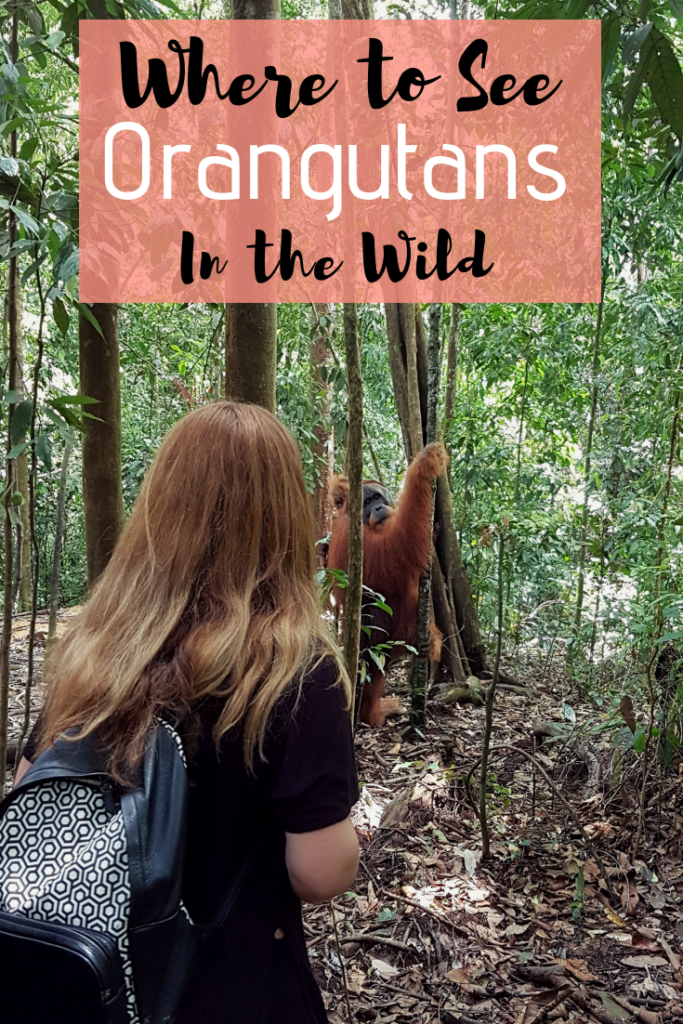Table of Contents
- Where to See Orangutans in the Wild In Sumatra, Indonesia
- How to get to Bukit Lawang Indonesia
- Travel Tips to Visit Bukit Lawang
- Weather in North Sumatra and When to Visit
- Where to Stay in Bukit Lawang Sumatra
- Trekking with Orangutans Tour in Sumatra, Indonesia
- Essential Things to Pack
- Conservation Efforts to Save Orangutans
Orangutans in Sumatra are critically endangered mainly due to the expansion of palm oil plantations. There are only about 6,000 Orangutans left in the wild in Sumatra and these numbers are quickly declining due to deforestation.
My experience of seeing Orangutans in the wild was one of my favorite trips of all time. I’m an animal lover and having the chance to come up close and personal with these amazing animals was truly special.
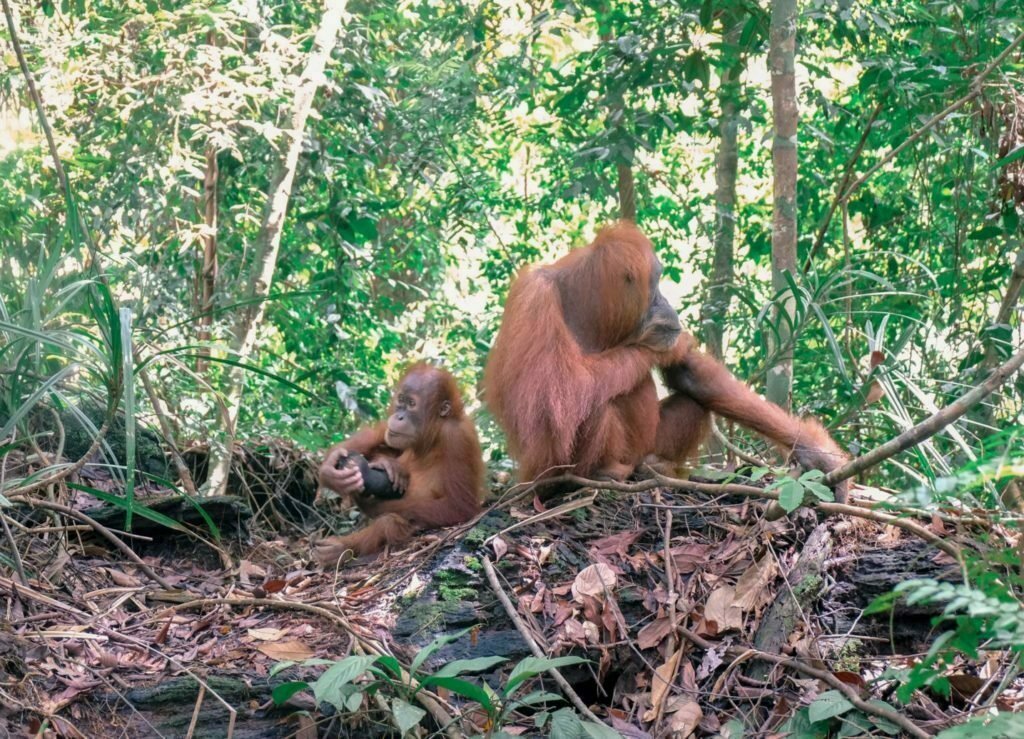
Where to See Orangutans in the Wild In Sumatra, Indonesia
There are actually two places left in the world where you can see Orangutans in the wild: Sumatra and Borneo. The Sumatran Orangutans are more rare vs. the Bornean Orangutans. The best place to see them in their natural habitat is in Bukit Lawang in North Sumatra, Indonesia.
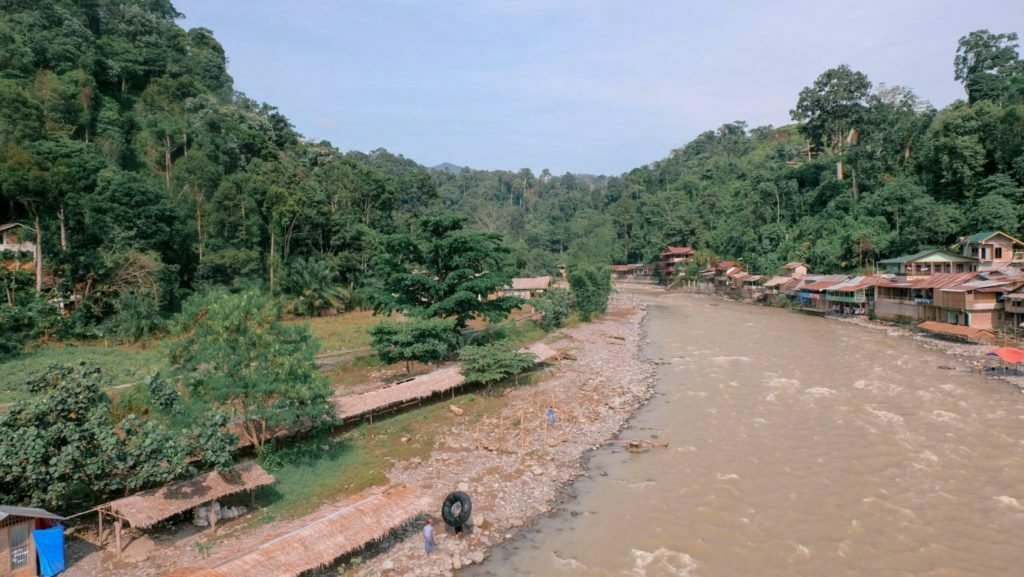
How to get to Bukit Lawang Indonesia
It’s best to fly into Medan Airport (KNO) and take a taxi to Bukit Lawang. The ride will take around 3 hours (2 hours if there’s no traffic). The road is fine in the first hour, but can get bumpy during the last hour.
You can arrange for your airport taxi through your guesthouse or negotiate a deal with one of the many taxi drivers in the arrival area of the airport. The ride should cost around $30 to $50, depending on your negotiation skills.
There are several extremely cheap flights to Medan from Kuala Lumpur or major cities in Indonesia. Some flights are as low as $30.
Public Transport from Medan Airport to Bukit Lawang
There are 2 public transportation options from Medan Airport, but both of them will drop you at Binjai, after which you will need to take a taxi (1.5 hours) to Bukit Lawang. This taxi ride will cost around $15 to $20.
1st option: Take the airport bus to Binjai. Cost: $3, duration: 1 hour.
2nd option: Take the train to Binjai. Cost: $3, duration: 1 hour. More info here.
My recommendation is to simply take a taxi from the airport, because you won’t be saving much if you use these public transport options. Especially given the fact that they get your halfway through your journey.
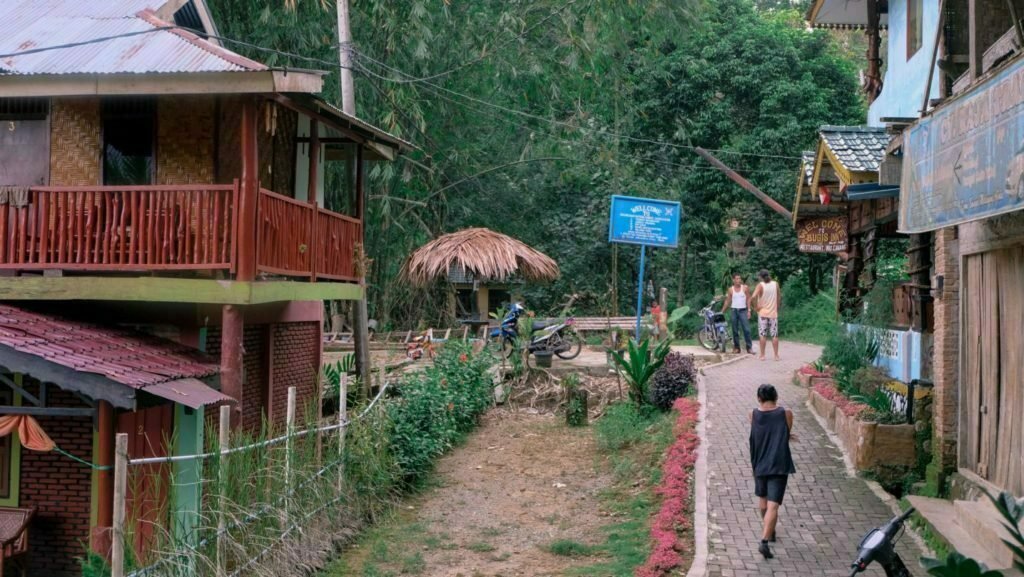
Travel Tips to Visit Bukit Lawang
1. Bukit Lawang is a very tiny village on the outskirts of Gunung Leuser National Park. As soon as you start walking in, most of the locals will start waving hello with a big smile. It’s a place where everyone knows everyone. You can definitely enjoy the slow-paced life during your holiday.
2. There are only a handful of basic accommodation options in the village.
3. There isn’t much to do at night apart from hanging out in or around your guesthouse.
4. The cliche saying “When it rains, it pours” applies perfectly here. After all, you are right next to the rainforest. When it rains, it’s best to wait it out, because you will get soaking wet.
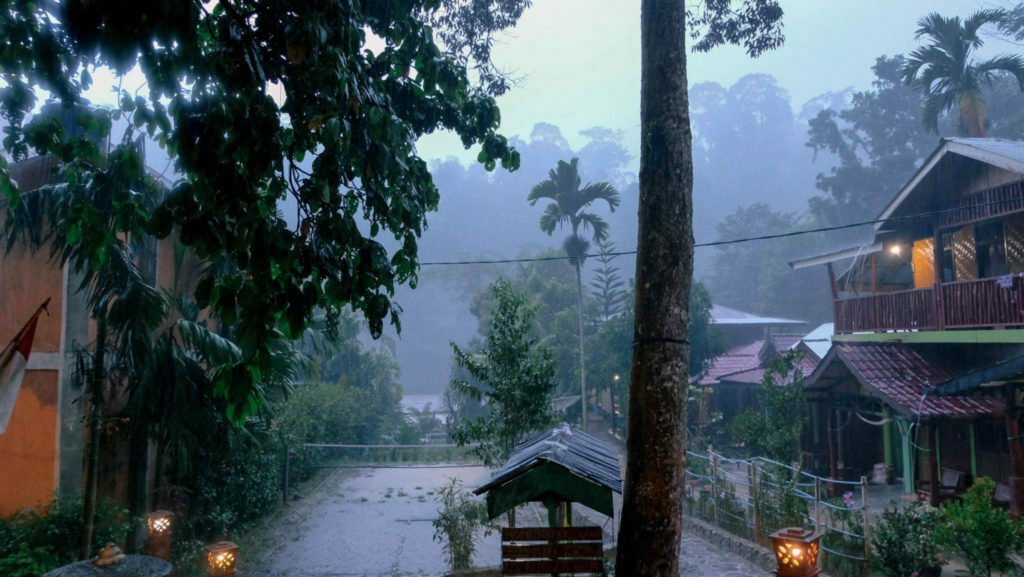
5. Bring cash to cover all your travel costs. There are no ATMs around and most places including guesthouses only take cash.
6. You will see lots of bugs! But you can survive them. As a person who is terrified of creepy crawlies, I was able to survive my trip without too many scary encounters. Being in the middle of the rainforest, there are mosquitos, spiders and some bigger bugs. Bring lots of mosquito spray and purchase a bug spray for your room and spray it twice a day.
7. The food is very basic. There aren’t many dining options, but thankfully Indonesian food is good. You will have a lot of fried noodles (Mie Goreng) and rice (Nasi Goreng).
8. North Sumatra (and most of Indonesia) has a majority Muslim population. You can still wear whatever you want as a tourist, but if you are passing through the heavily populated cities and want to make stops along the way, avoid very short dresses or shorts.
9. Indonesians are some of the friendliest people in the world. Most locals will greet you with the biggest smiles.
10. Forget about having good WIFI. The internet is the greatest and you might not have very good cell coverage either.
11. You will experience power cuts. There are some electricity cuts that happen daily, but thankfully most places have generators.
12. Keep your hotel doors and windows closed at all times, otherwise, you will find monkeys (not Orangutans don’t worry!) going through your stuff in your room.
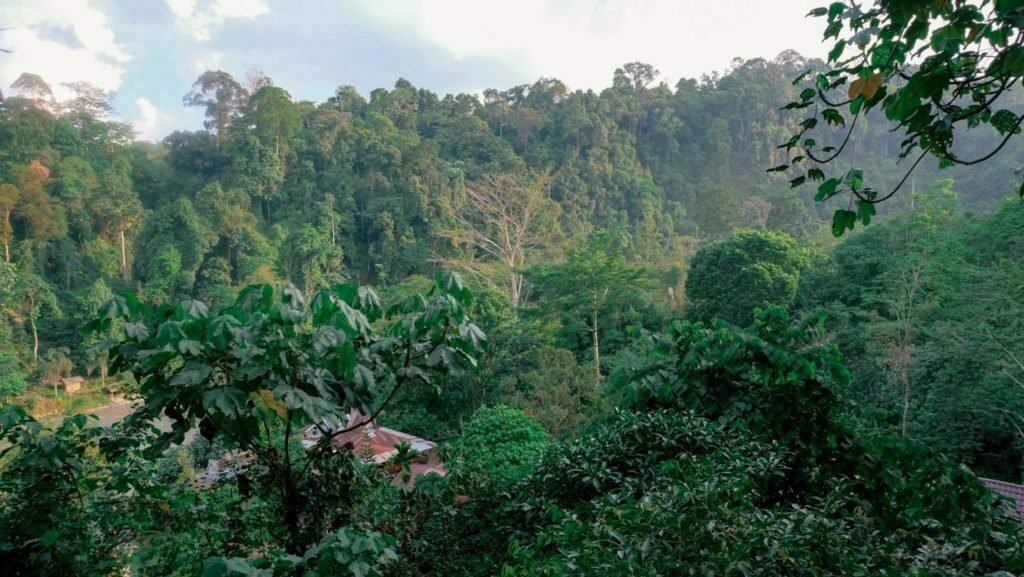
Weather in North Sumatra and When to Visit
The weather in Indonesia has only two seasons: wet and dry. It’s best to avoid the wet season, especially if you’re going to do lots of outdoor activities.
In North Sumatra, the wet season is from October to January. It’s best to visit from April to August. More weather info here.
Where to Stay in Bukit Lawang Sumatra
After doing an extensive research to find the best guesthouse, I found Hotel Orangutan to be the best accommodation option. My stay was just perfect and I highly recommend it. Not only that, the hotel is super affordable too. The deluxe room price starts at $37/night.
It’s important to mention that your guesthouse will be arranging your tours to see the Orangutans, so it is essential to pick a good one.
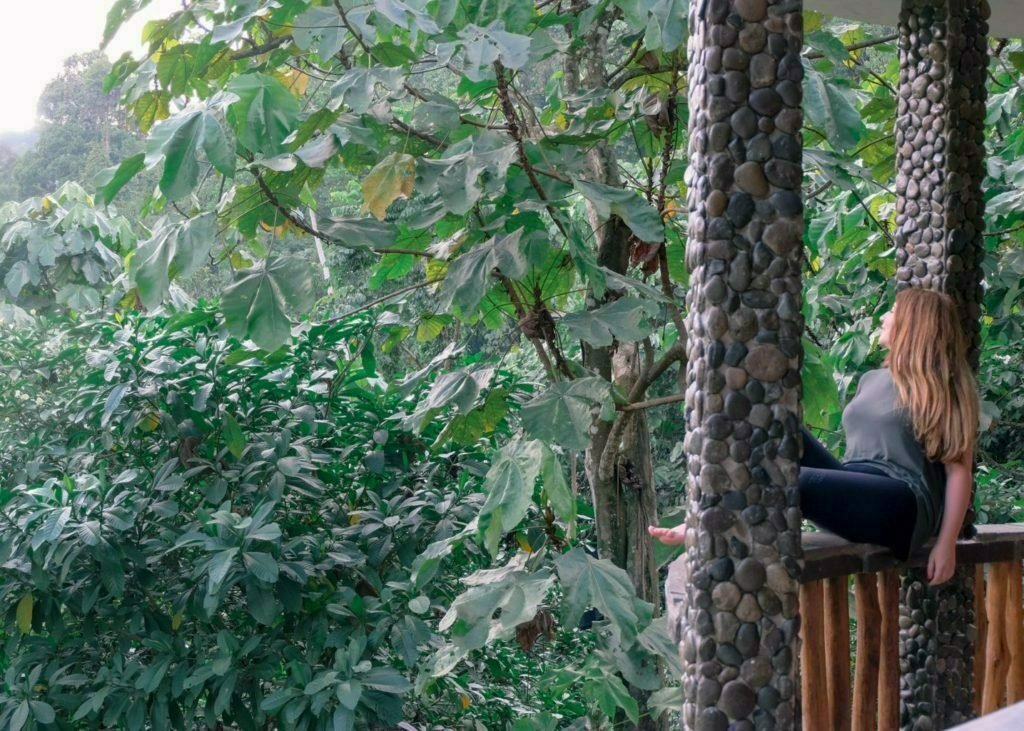
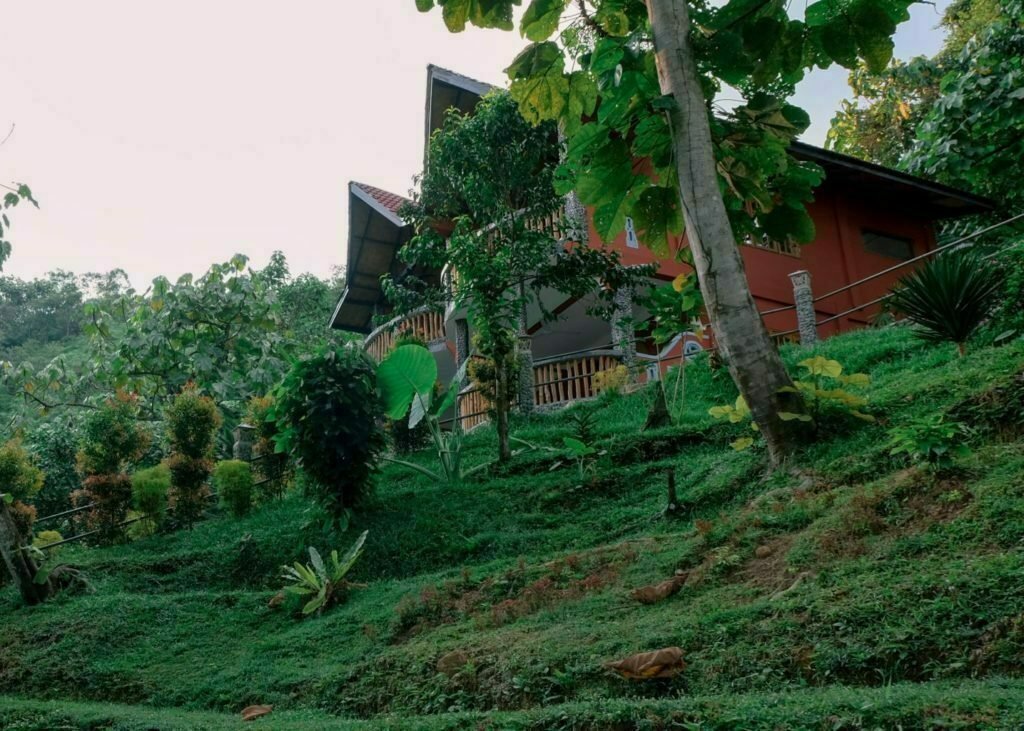
The Rooms at Hotel Orangutan
I stayed in the Deluxe Room all the way at the top of the hotel. My room was super spacious with a beautiful large balcony. The bed was very comfortable and covered with a mosquito net. There is no AC in the rooms, but there are large fans both inside the room and on the balcony, which make it perfectly cool.
The bathroom was my favorite part. The shower area is actually open (covered with a net) and overlooks the jungle! After experiencing several outdoor showers in Southeast Asia, this was still an interesting one because it feels like you’re literally taking a shower in the jungle.
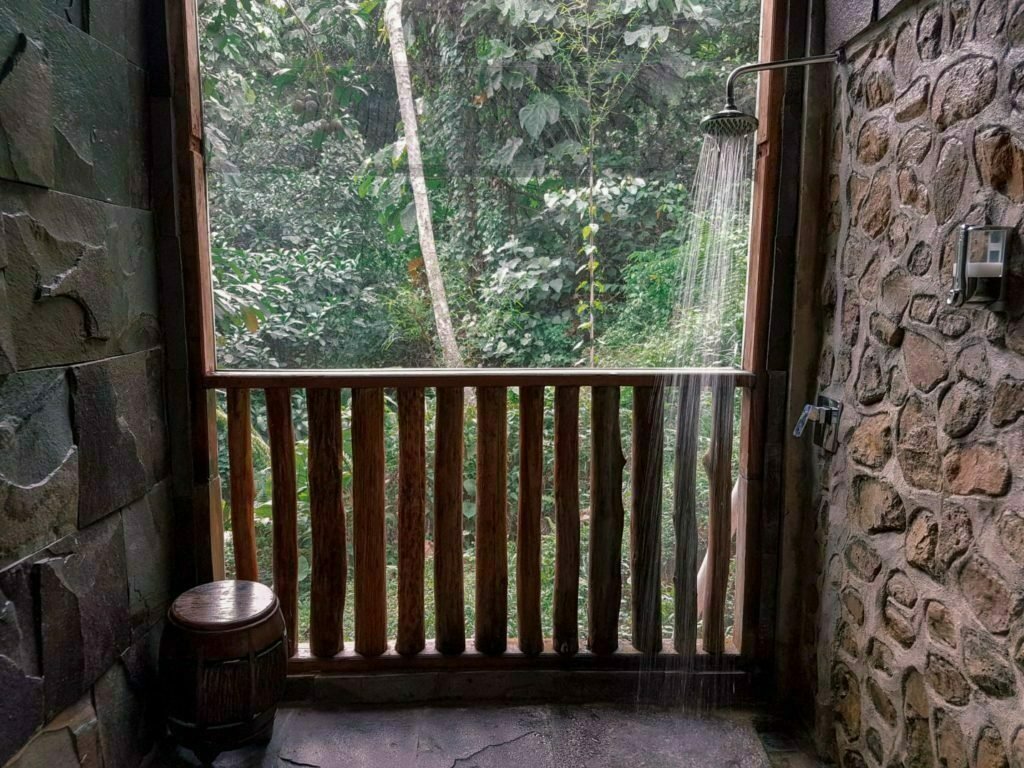
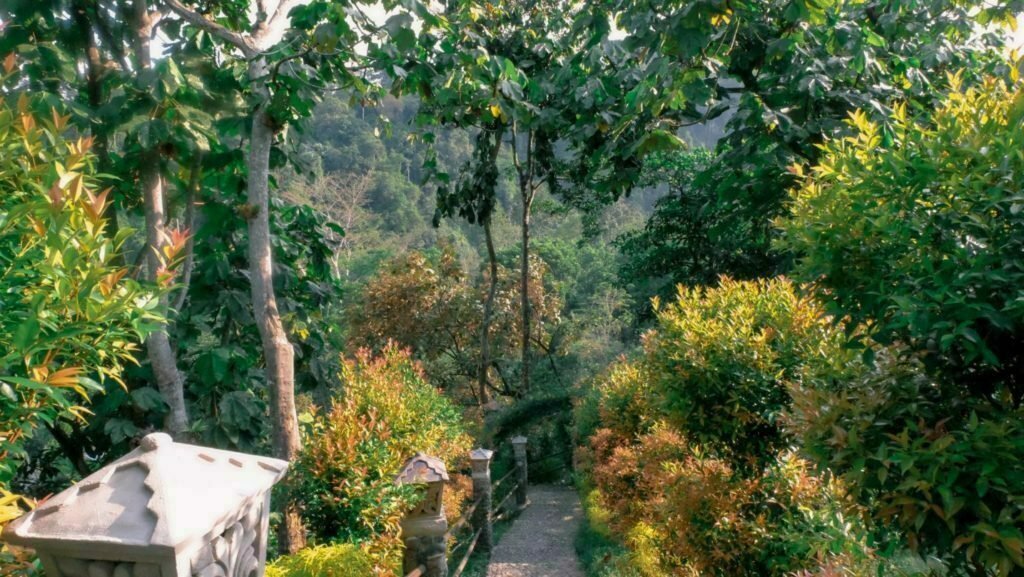
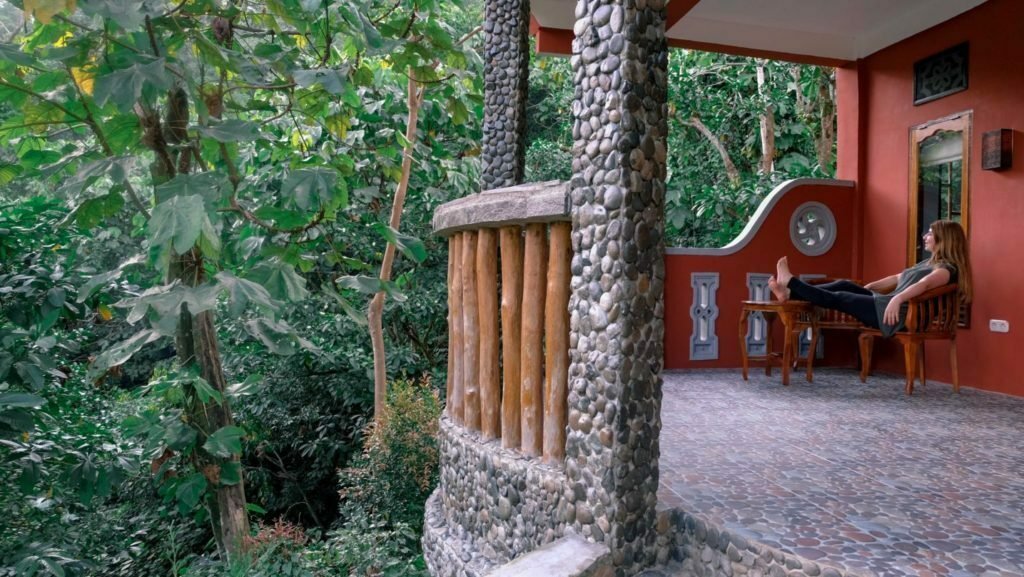
Waking Up with Monkeys on My Balcony
The first morning, I woke up to a few sounds on my balcony (apart from the amazing sounds of the rainforest). I was curious to know what was happening, so I opened the door to see over 30 to 40 little monkeys just hanging out! When I stepped outside, they all stopped what they were doing and stared at me for a bit. I decided to have a seat and enjoy watching them do their monkey business. Within 15 minutes they moved on to a different location.
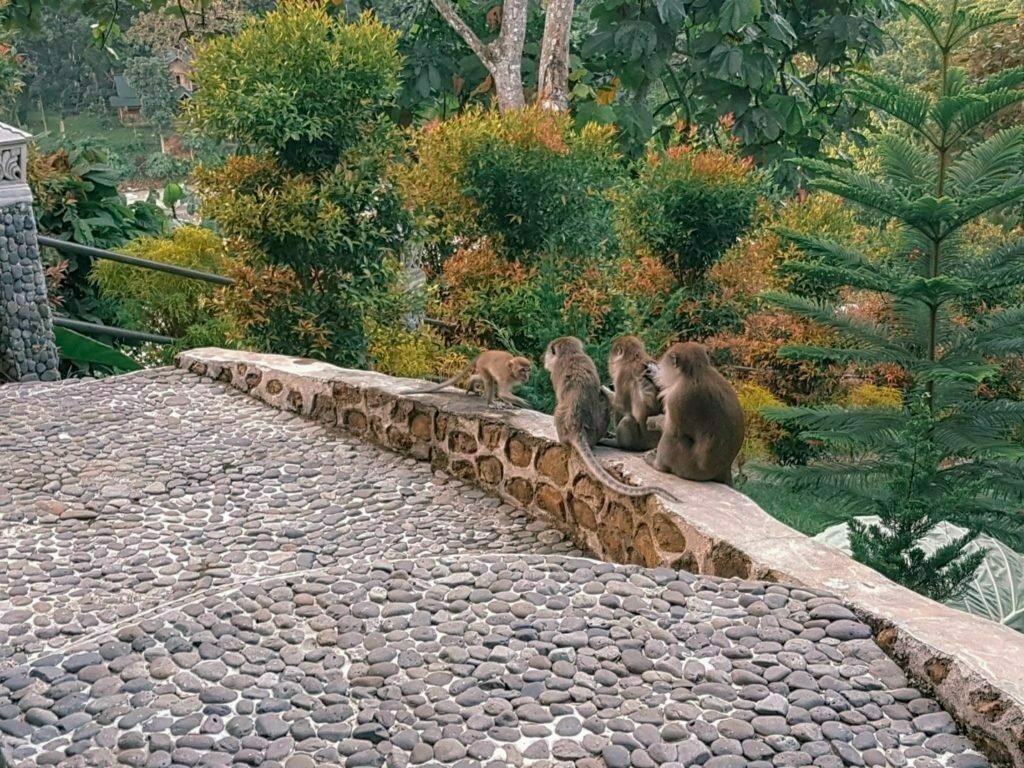
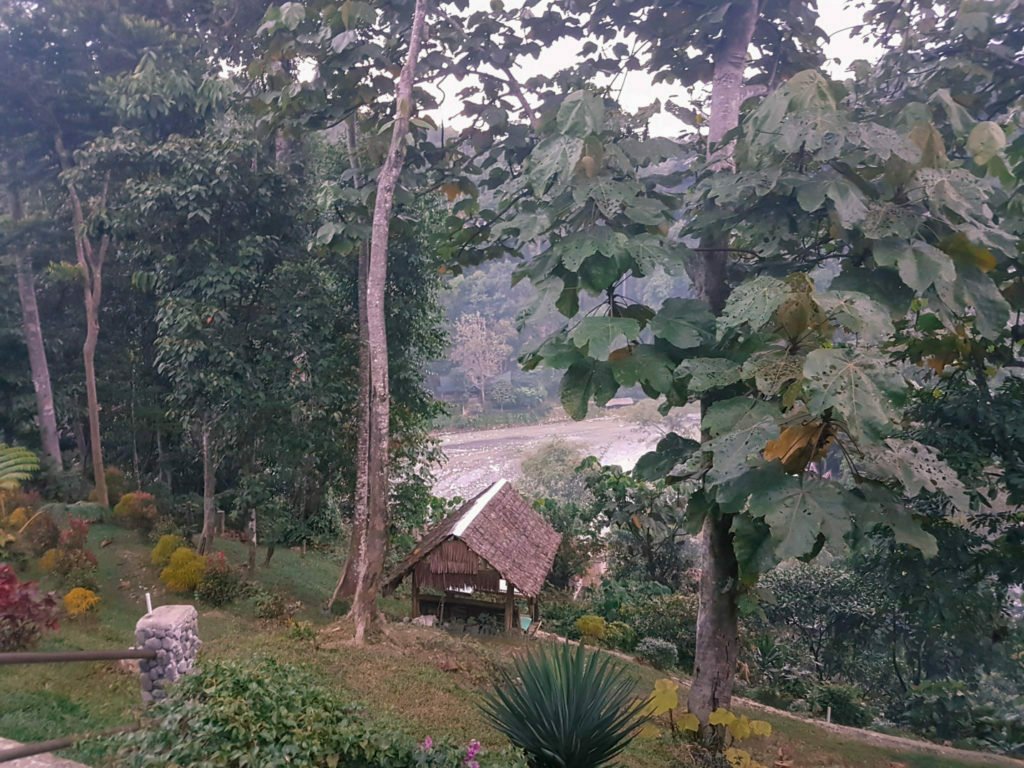
The Food and Staff at Hotel Orangutan
The highlight of my stay was definitely the staff. They are some of the friendliest and most helpful hotel staff I ever came across. The tour guides that took us on the trek were also excellent.
The food and drinks were really good at the hotel restaurant (which is right next to the reception) and also super affordable. The breakfast is great and the coffee is out of this world. Sumatran coffee is well known globally. I loved it so much that I asked the manager to tell me where they got their coffee. I ended up buying quite a few bags before I left.
Trekking with Orangutans Tour in Sumatra, Indonesia
Orangutan Tour Options
There are several tour options you can book in Bukit Lawang. You can choose to do a day tour or book a 2 to 7 day tour which includes a camping in the rainforest. The longer you stay in the rainforest, the more chances you have of spotting different types of animals and wildlife. I booked my tour through Hotel Orangutan.
Although Gunung Leuser National Park is famous for Orangutan spotting, there are lots of other types of wildlife including: Sumatran elephants, Sumatran tigers, Sumatran rhinoceros, Siamang, Sumatran serows, Sambar deer and Leopard Cats. Of course, these animals are very rare to spot, especially the tigers, so there is nothing to worry about.
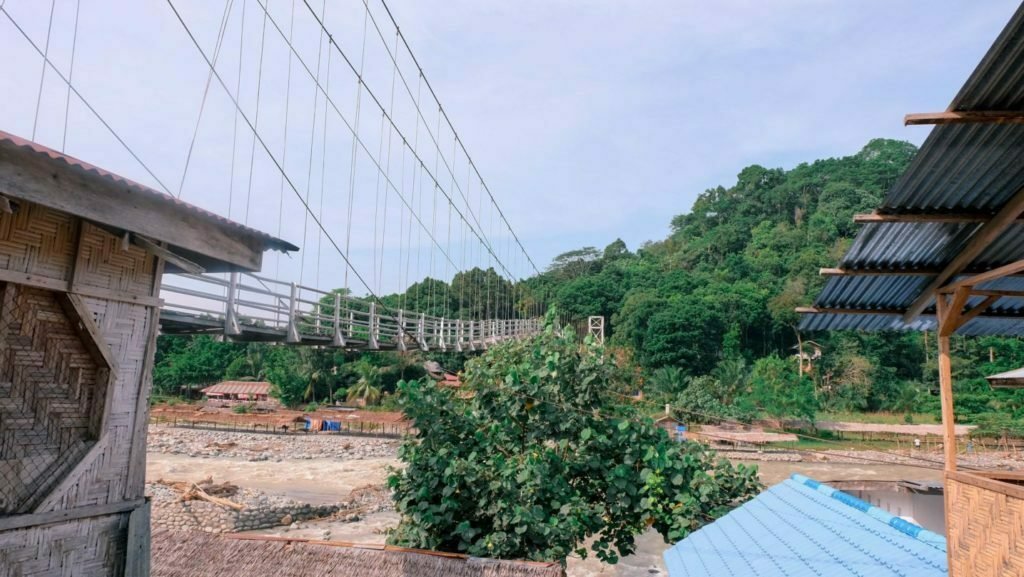
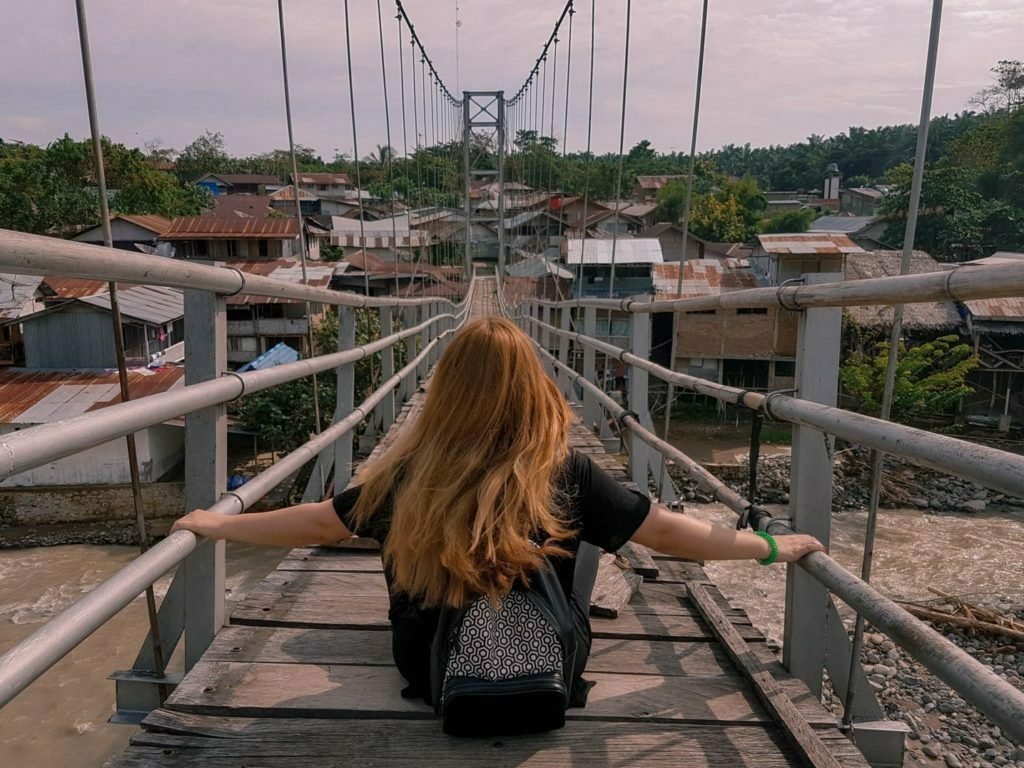
All of the tours can be booked through Hotel Orangutan. I highly recommend booking through them, because the guides are amazing and they really care about the animals and rainforest.
I did the day tour and chose to sleep in the hotel. I was able to see several Orangutans during my 1-day trip. If you are not a camping kind of person, the day tour is perfect for you. You will still get to experience the Orangutans up close.
Day tour cost: around 60 euros (the price depends on the number of people in the group)
Day tour duration: 8 hours
Inclusions: lunch, guides, entrance fee to national park, tubing (optional)
Other fun tours in Bukit Lawang: Bohorok River tubing, Village tour, Bat Cave tour, Tangkahan trip to bathe with elephants.
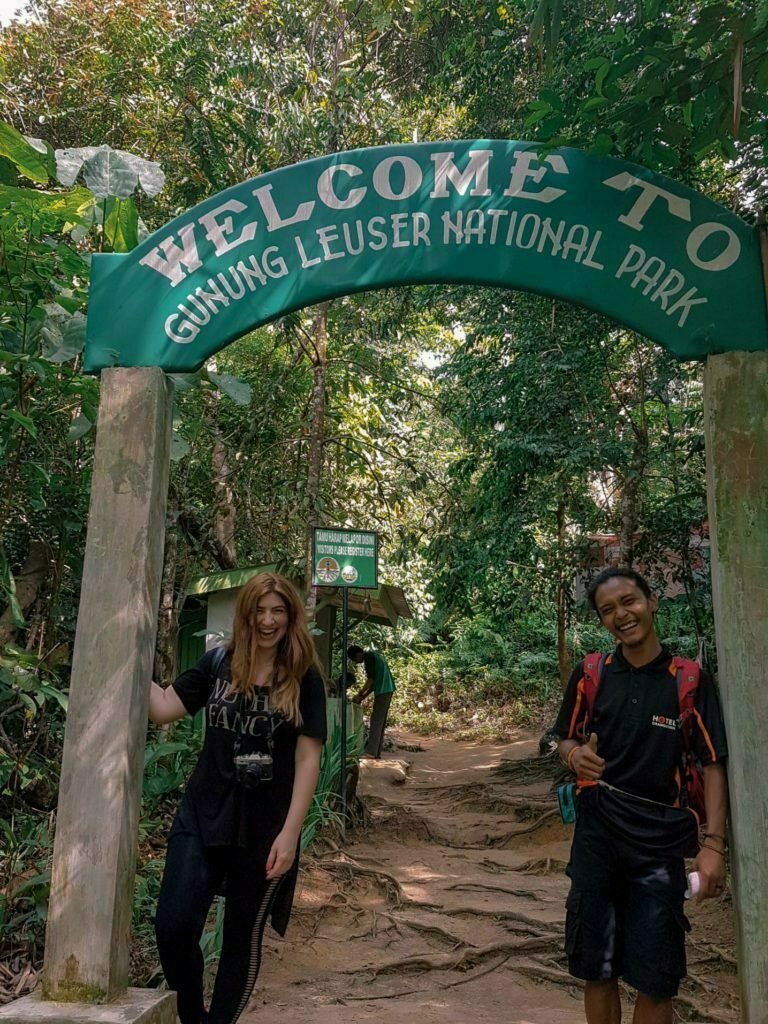
Orangutan Tour Experience
We started our trek from the hotel and walked through the village and onto the famous bridge to cross the Bahorok River. Given the proximity of the hotel to Gunung Leuser National Park, in under 30 minutes, we already found ourselves in the jungle.
As soon as we stepped foot into the rainforest, we came across several Thomas Leaf Monkeys. These monkeys were actually super friendly and are used to human encounters. Most of them approached us mainly hoping to get some food. They are not aggressive at all, so don’t be alarmed if they come close to you.
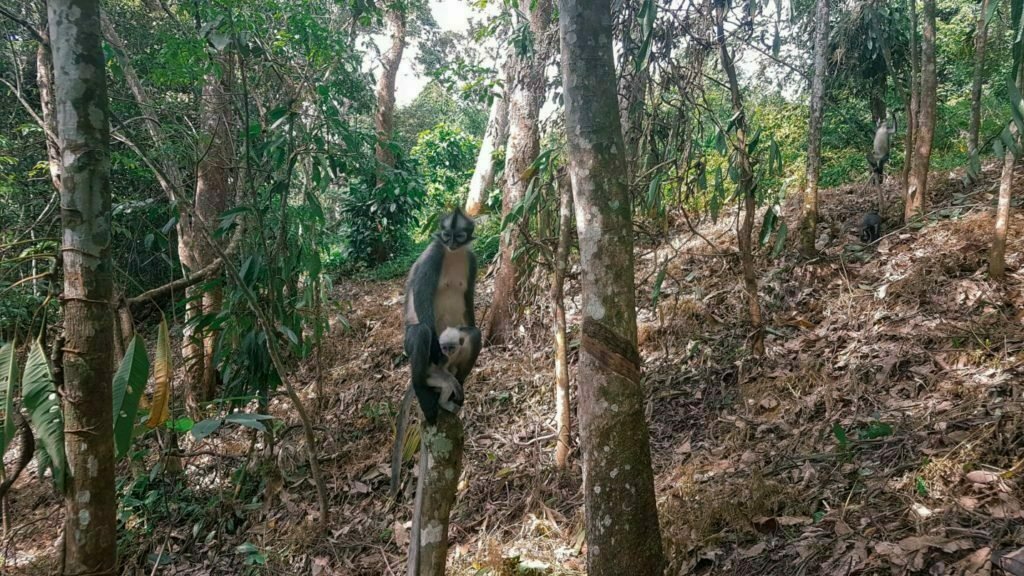
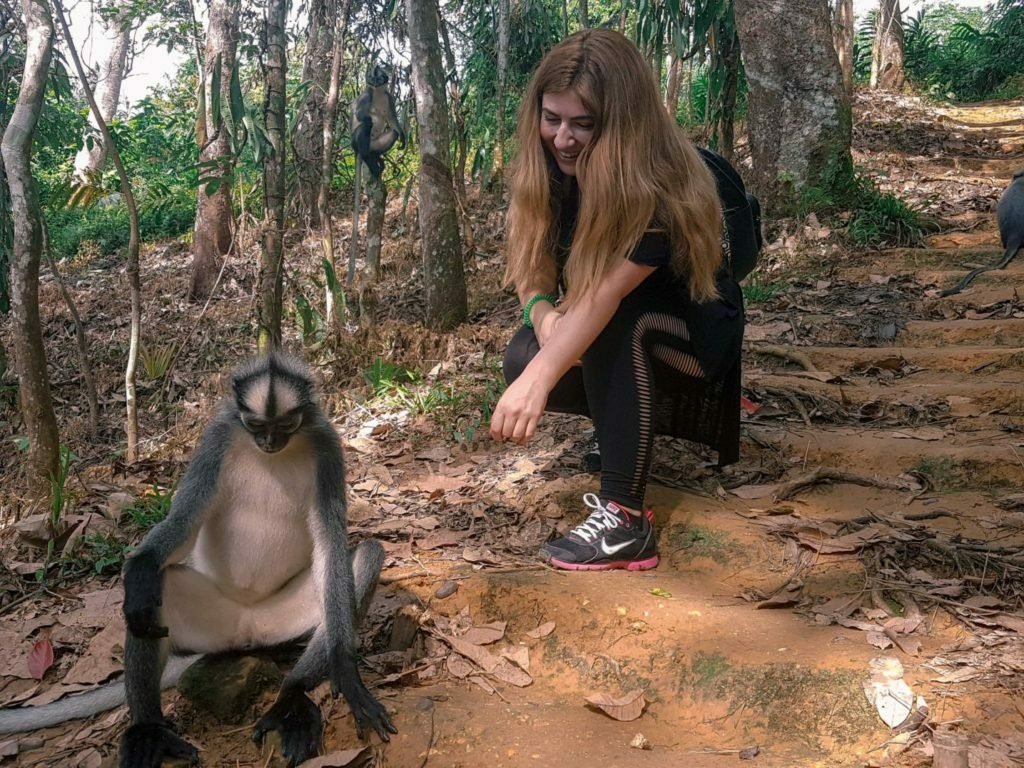
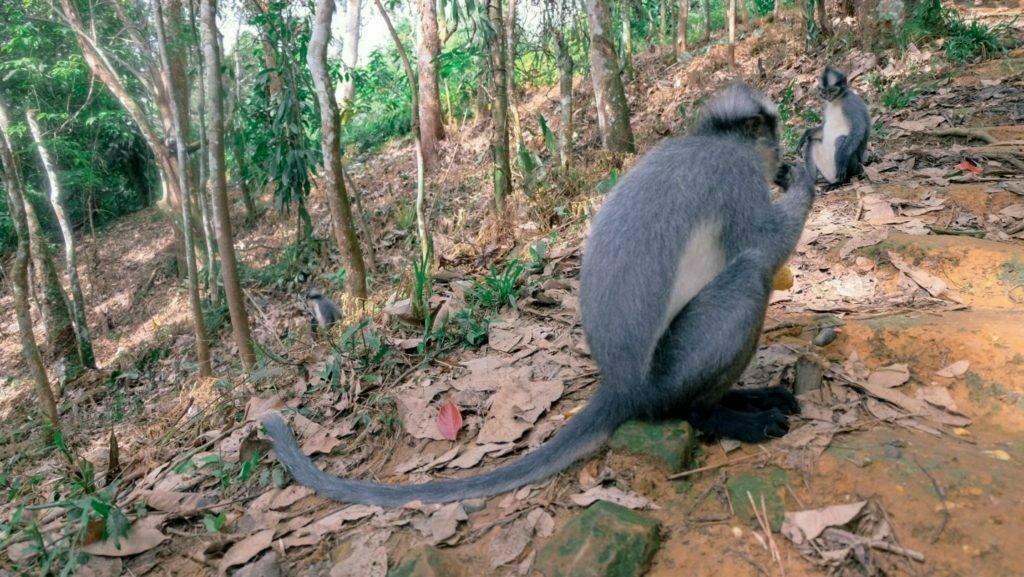
One thing you will immediately notice is the extreme heat and humidity. You will be drenched in sweat from the very first minute. The climate is quite rainy and humid all the time. It’s essential to bring lots of drinking water with you and possibly a change of clothes.
My tour was led by 2 guides and we were a total of 3 tourists. We started coming across other tour groups during our trek, who each had at least 10 to 15 people in their group.
After about 1 hour of trekking, we suddenly spotted our very first Orangutan! She was a medium-sized female mother with her baby. Both of them were high up on the tree and the baby was monkeying around from branch to branch. It looked like they were used to seeing other humans, because they acted as if we were not even there. The mom did give us a few looks just to make sure her baby was safe. It was amazing to just watch them go on with their lives in their natural habitat.
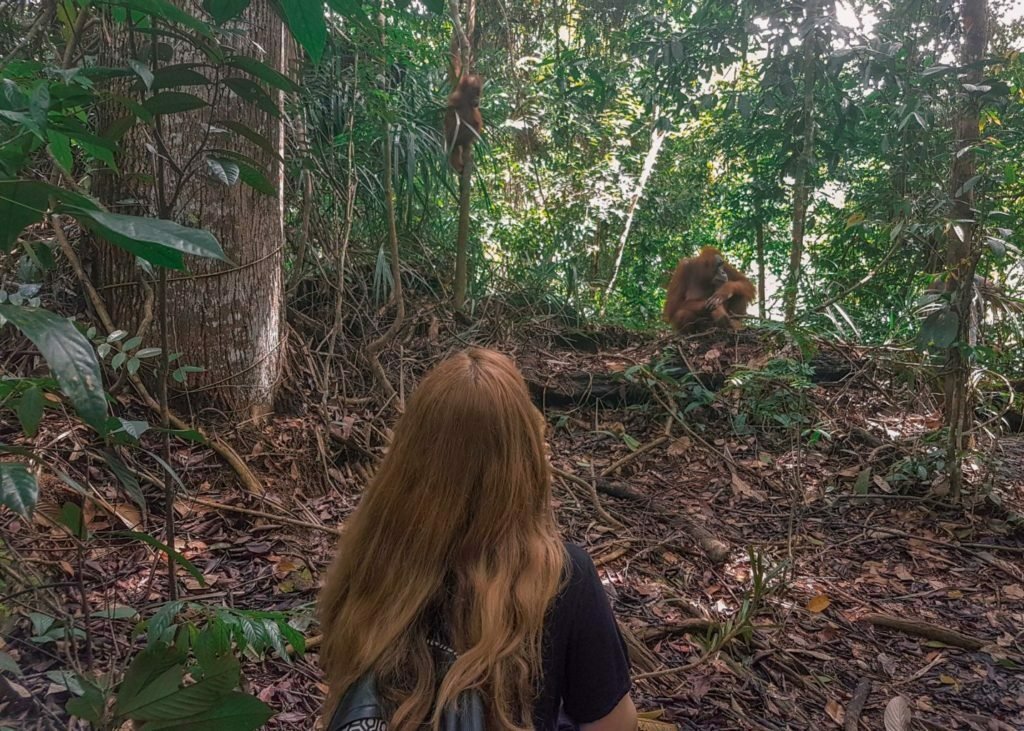
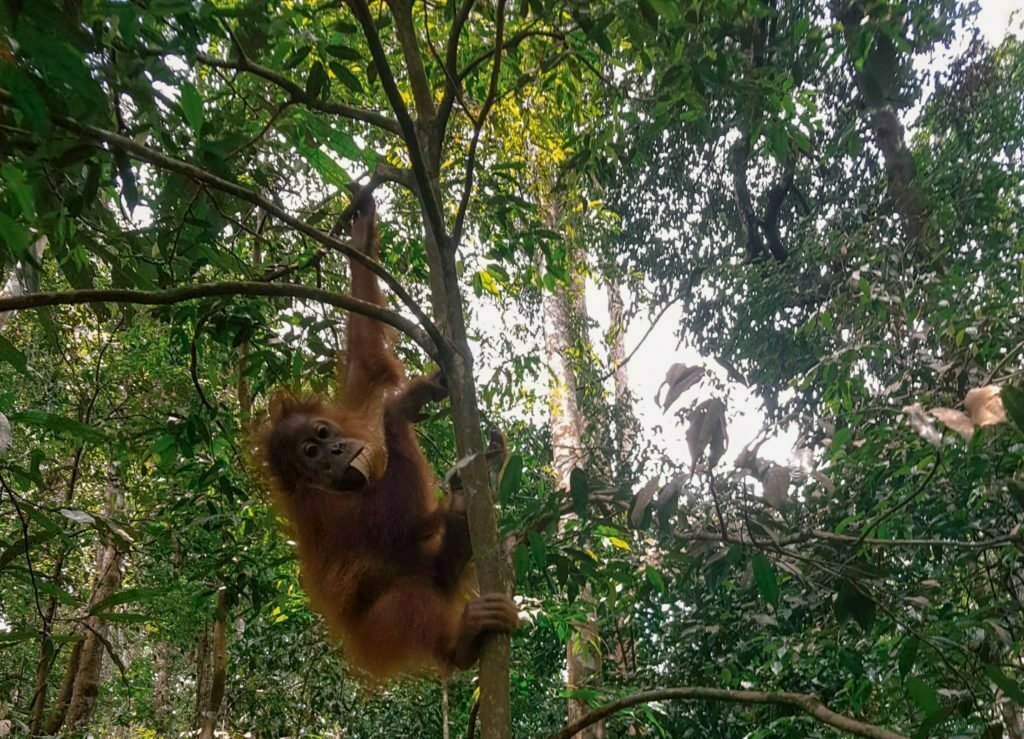
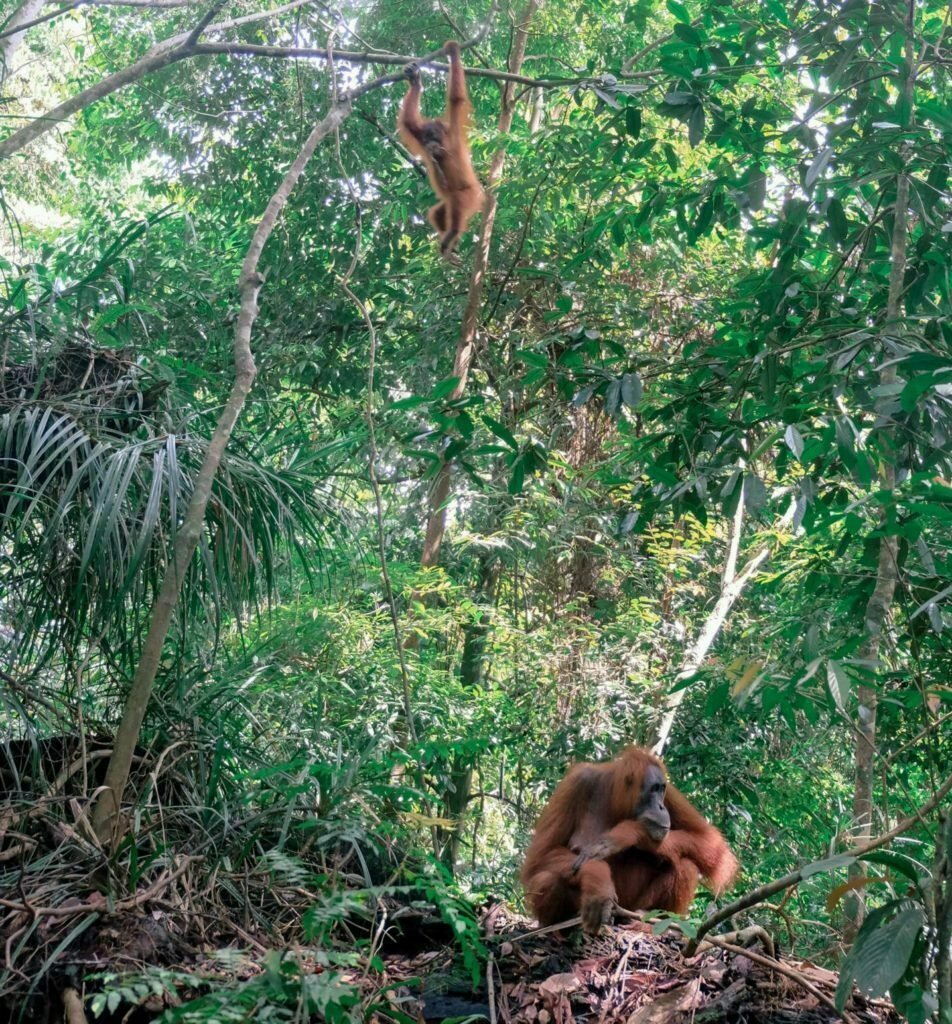
We continued trekking further into the forest and came across several female Orangutans. We were warned not to feed them, so that they don’t get used to relying on tourists to gather their food. We saw a few forest rangers during our trek that make sure tour groups are following the rules.
Warning: To ensure the conservation of Orangutans in the wild, please do not feed them or touch them. This is crucial for their survival and they can easily catch diseases from humans. We did see other tourists feeding them but stayed away.
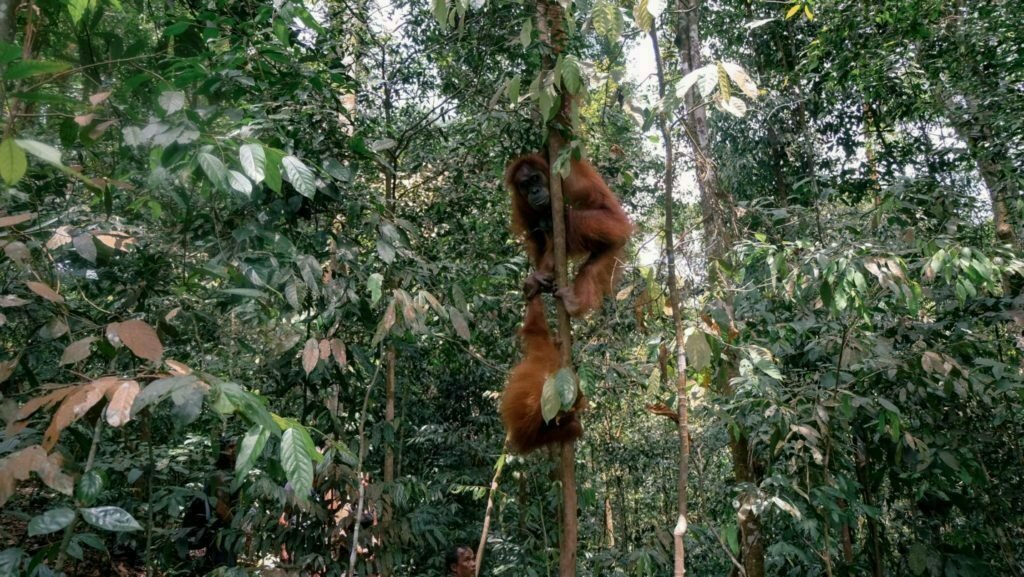
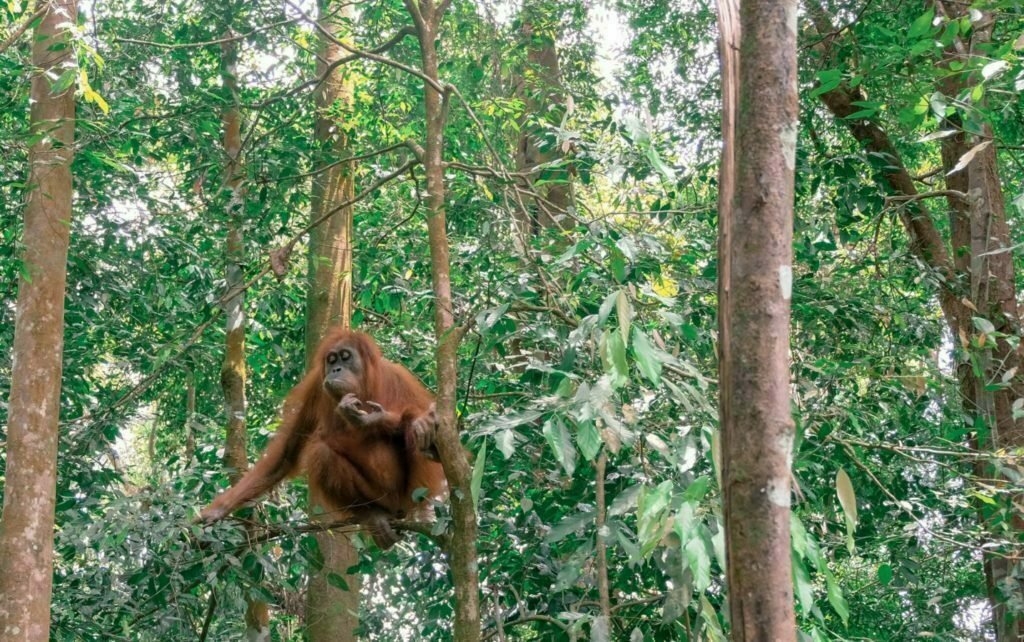
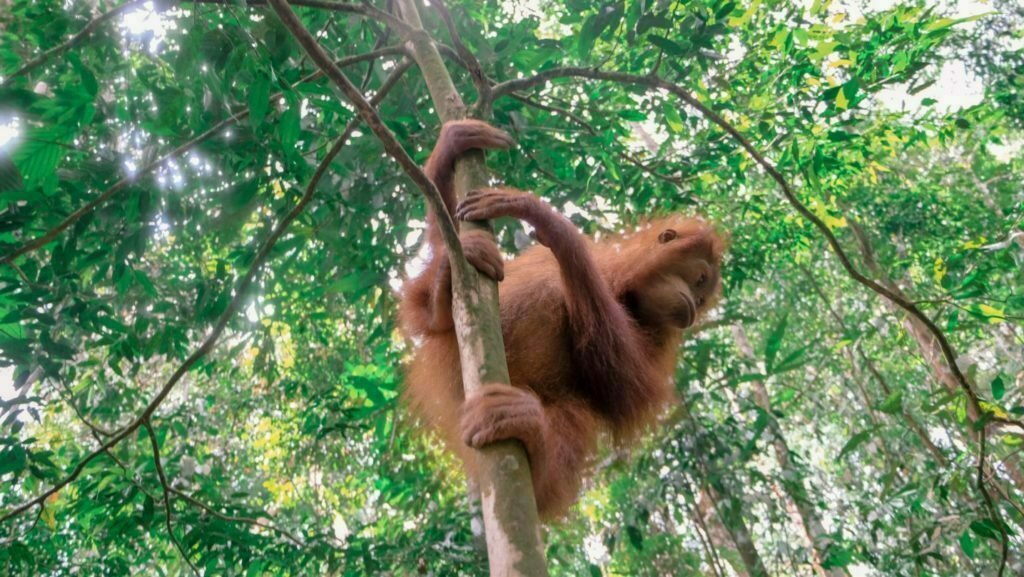
Around 3 or 4 hours into our trek, one of the guides told me to stop moving and stay quiet. I was quite alarmed and waited to see what was going on. He suddenly pointed behind me and I turned to see a massive male Orangutan just a few meters away! I can’t begin to explain the feeling of excitement and happiness I felt at that moment. This one was really huge and he wasn’t on a tree. He was walking around right next to us!
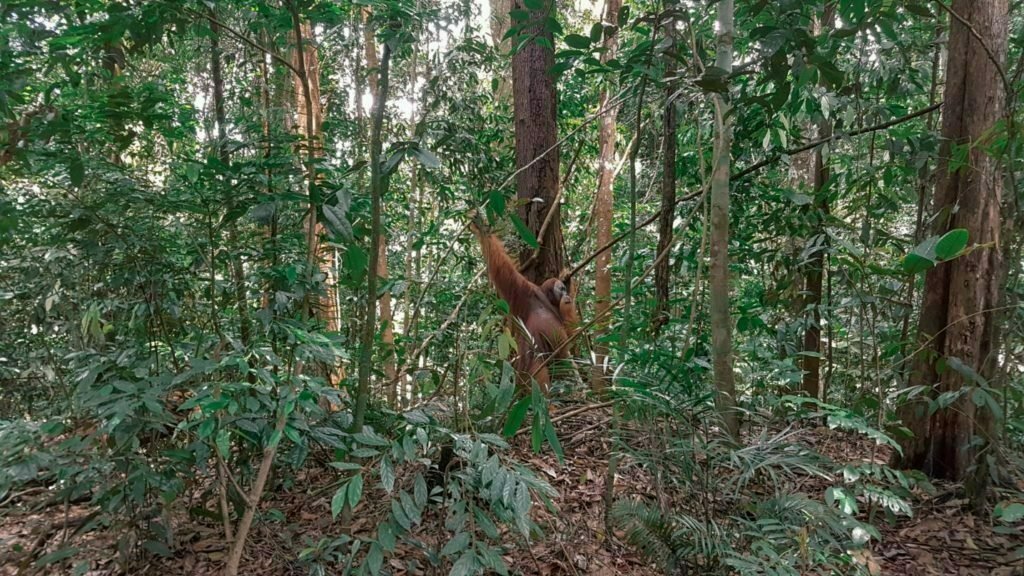
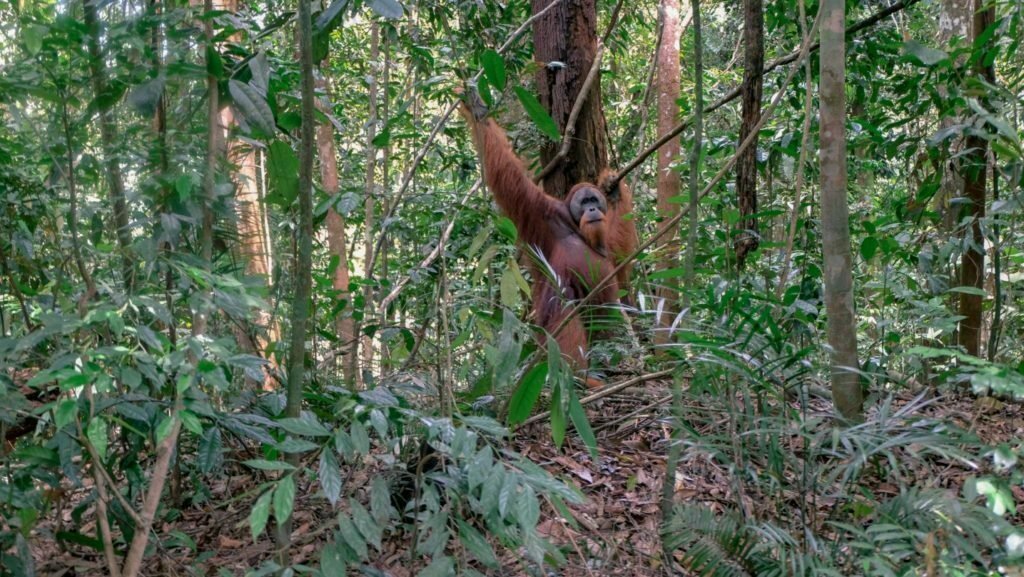
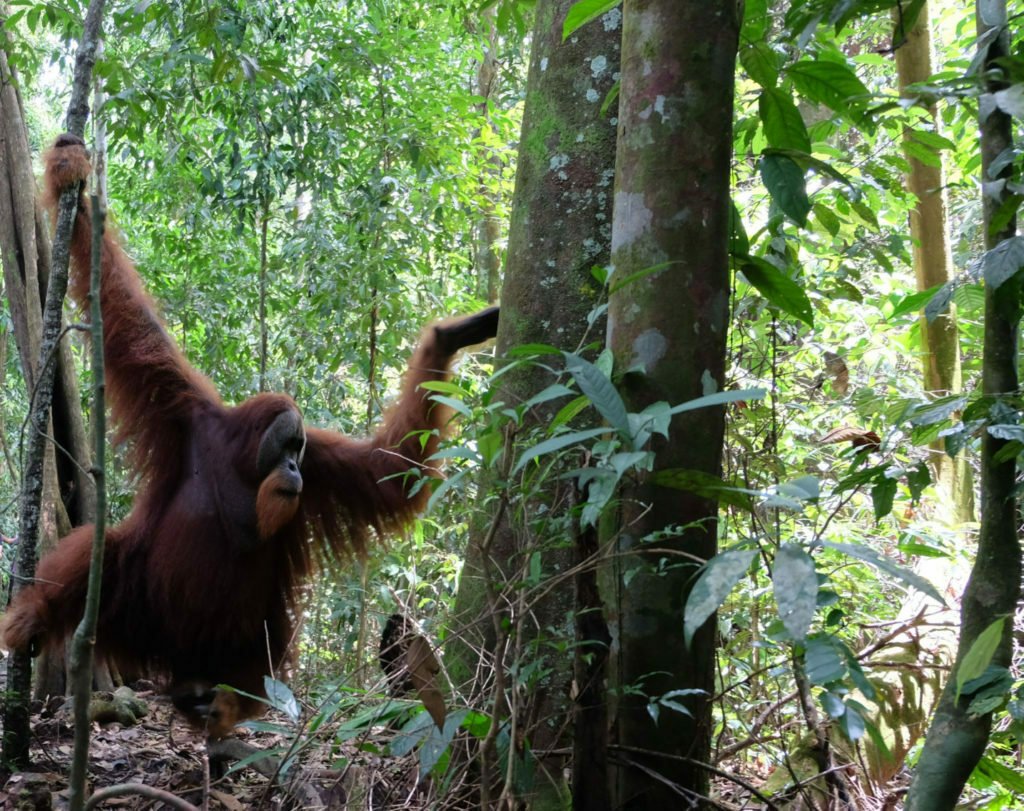
I gave my camera to the tour guide and tried to go as close as possible to see him up close. As I was posing for a picture, the Orangutan suddenly stopped and started staring at me from head to toe. I didn’t feel scared at all. In fact, I felt a sense of peacefulness take over me. It was as if we were buddies just hanging out in the jungle (keeping a safe distance apart of course!).
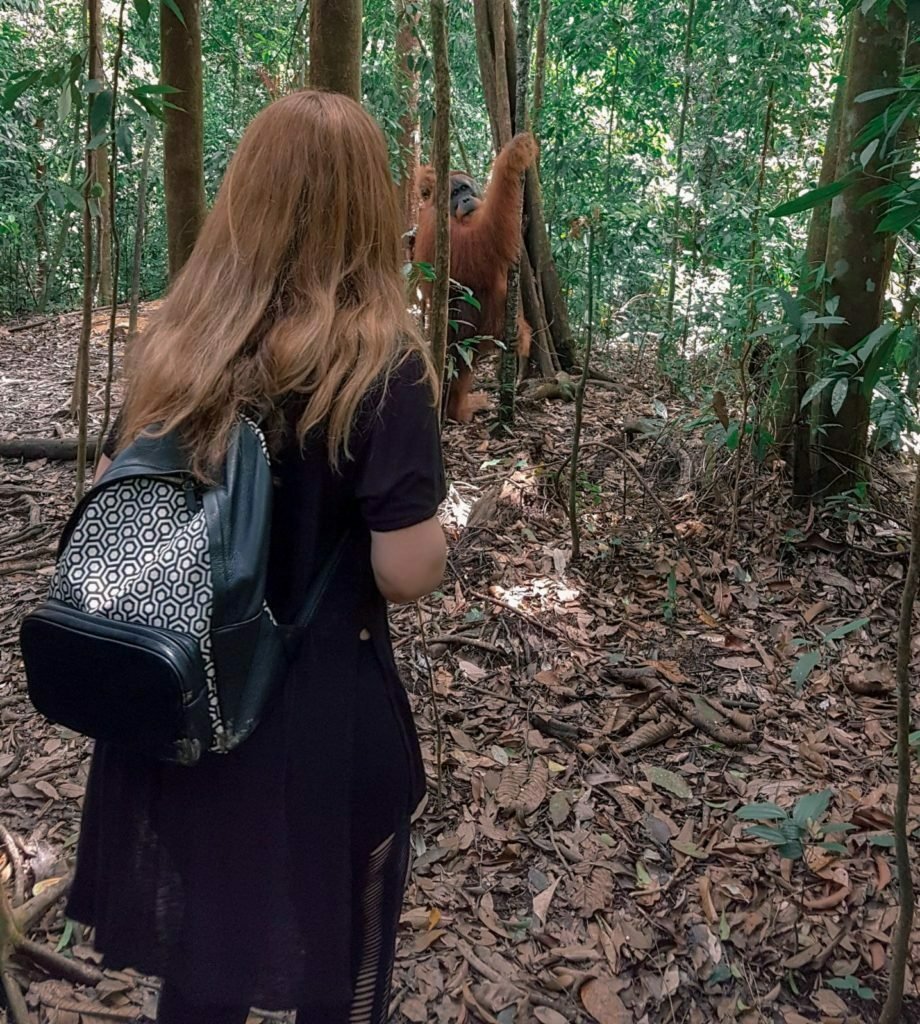
In this moment, my guide decided to tell me to be extra careful, because male Orangutans can carry 4 humans up a tree (funny guy!). In reality, my Orangutan buddy was so gentle. After chilling with us for a few minutes, he walked away and moved on with his journey. I will remember this very special encounter forever. It was definitely one of my favorite travel moments of all time.

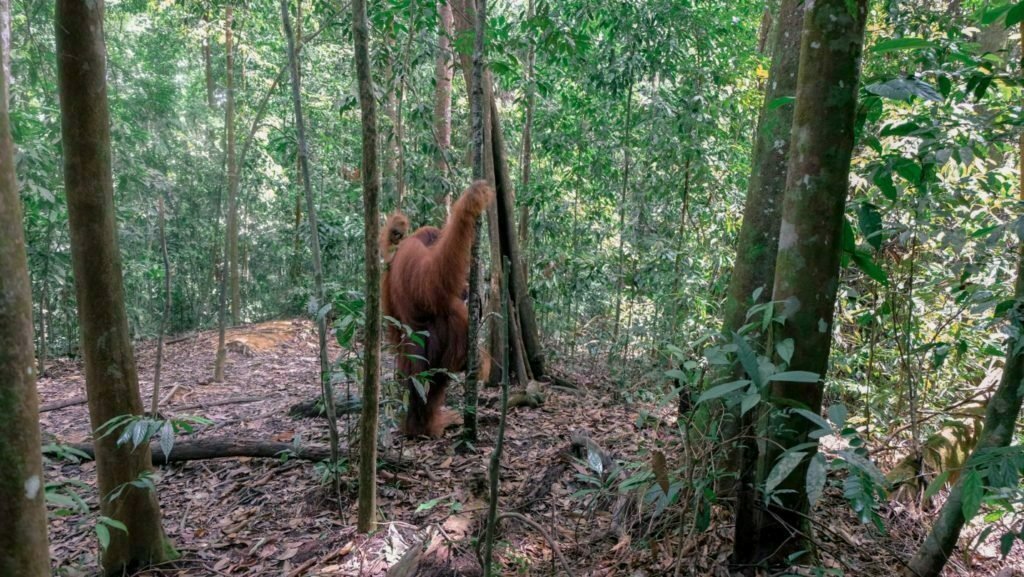
Fun fact: you will come across several females and their babies in the forest. This is because males pay a visit just for mating reasons and then leave. It is actually much more rare to spot the big male Orangutans during your journey.
Four hours into our journey, we sat down in the jungle and the lovely guides prepared our lunch. The meal is basic but good with some rice, chicken and fresh fruits. The guides made sure to clean up every trace before we left our lunch spot.
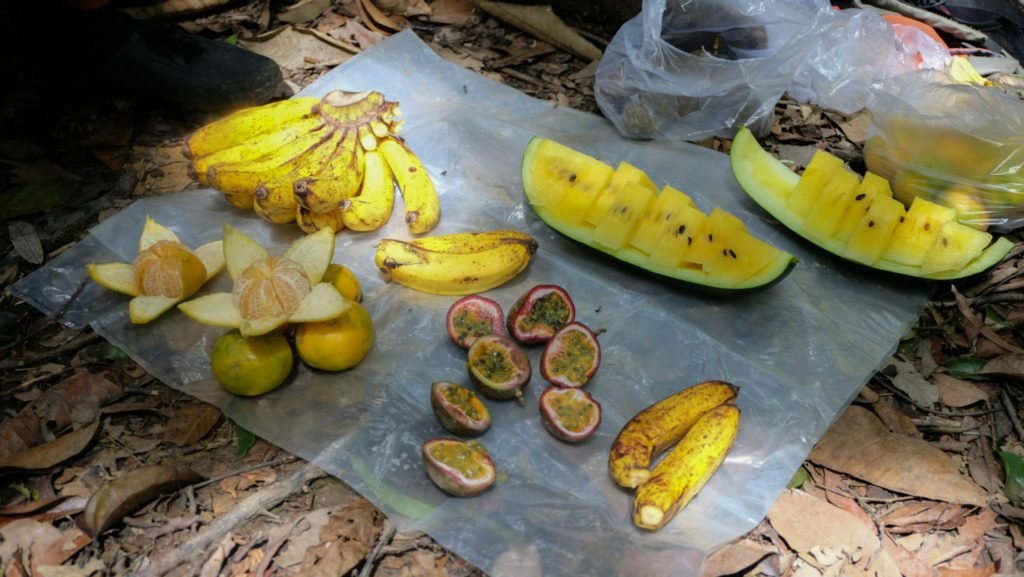
We started making our way back through a different pathway where we encountered even more females and babies. I think we saw a total of over 10 different Orangutans, which was absolutely perfect. Towards the end, we stopped by a small waterfall for a very refreshing swim.
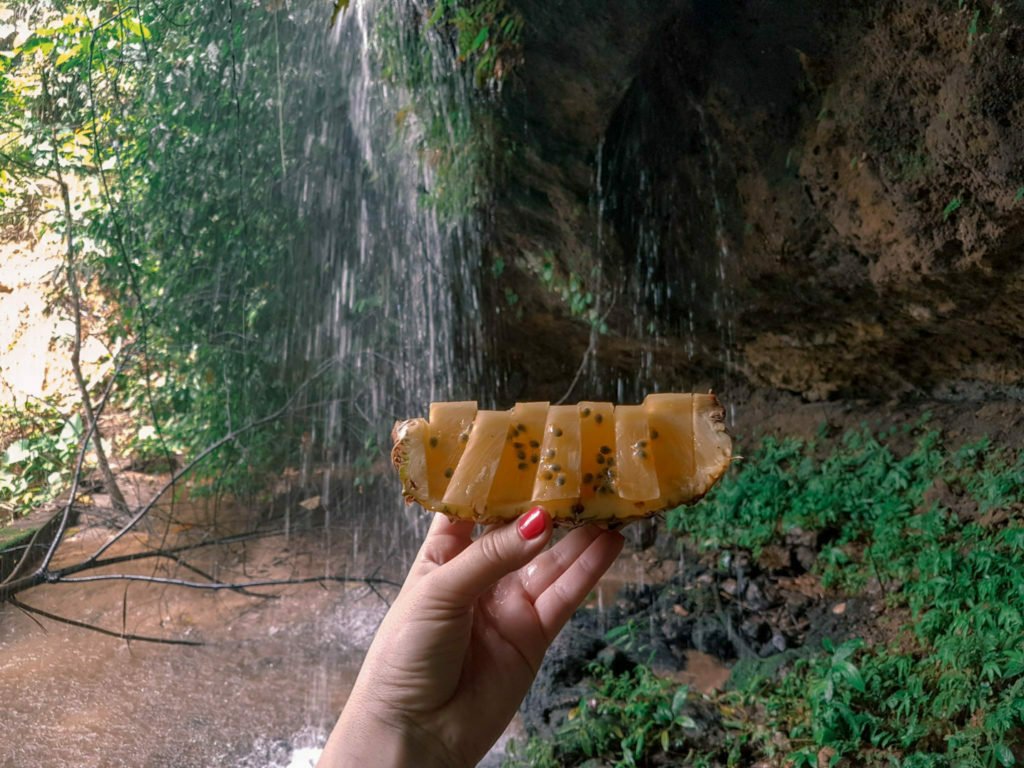
Was Trekking in the Rainforest Difficult?
The total journey was about 8 hours. If you have a basic fitness level, you will be completely fine. There were some families with young kids and even seniors doing the trek.
The beauty of the rainforest and the close encounters with Orangutans will make you forget about the heat and humidity. The 8 hours felt more like 2 hours in my case. Just make sure to have lots of drinking water (at least 1.5 liters) and comfortable shoes.
The trek going upwards into the forest was easier than the way down. The pathway that we took going back down was a bit slippery and muddy, but the guides were so helpful and they let us walk at our pace.
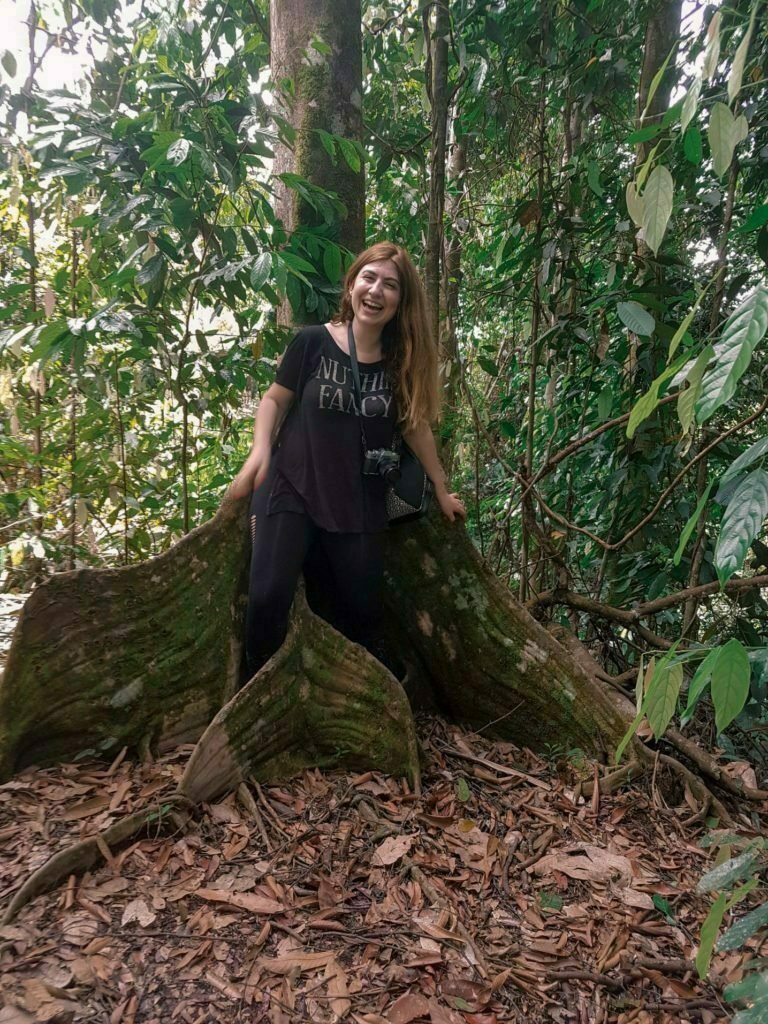
Essential Things to Pack
Trekking in the rainforest means that it could rain at any point in time. It’s important to protect yourself and your camera gear. You will also need a strong mosquito repellent and hand gel/wipes.
Make sure to pack: dry bag, backpack cover, hand gel, wipes, mosquito repellent, power bank, walking shoes, camera or Go Pro.
Conservation Efforts to Save Orangutans
The biggest threat to Orangutans in Sumatra is losing their homes. Rainforests are being chopped down for timber or to make room for palm oil plantations. These amazing animals are declining in hundreds every single year. Another problem they face is illegal trading. Unfortunately, Orangutans are traded as pets and the babies are snatched from their mothers very early on in their lives.
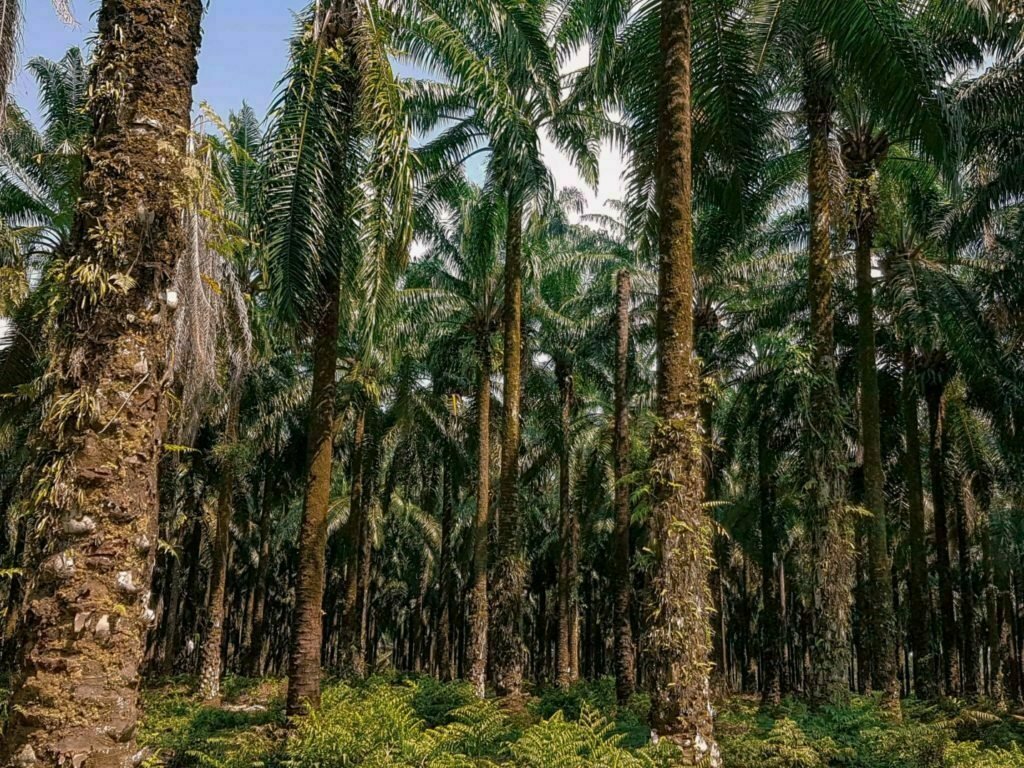
During our drive from the airport to Bukit Lawang, I was heartbroken to see so many palm oil plantations for several miles. It was quite shocking to see how much was cut down to make way for these plantations. I avoid using any products that have palm oil in them. These products are things we use regularly in our daily life.
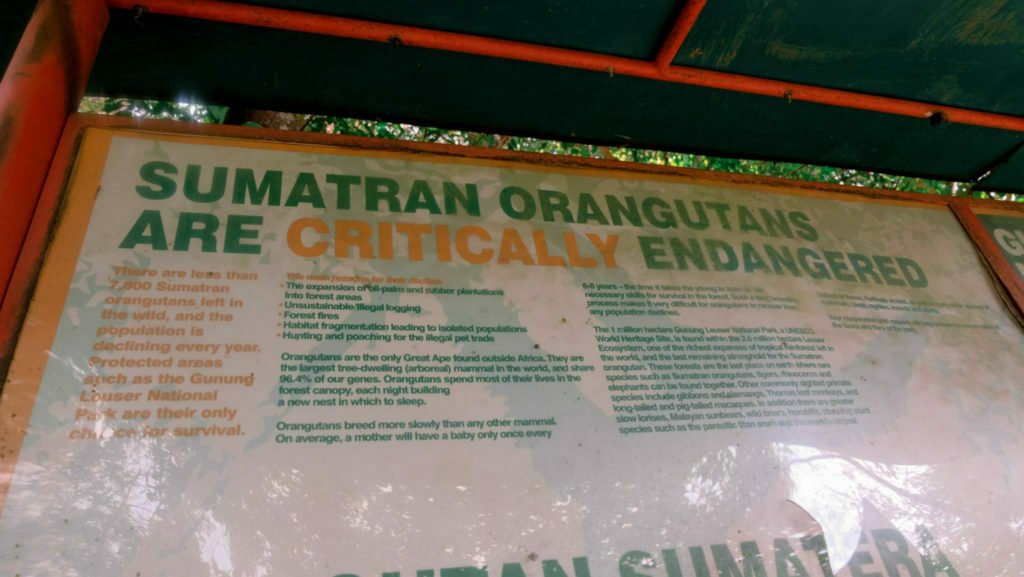
There are some great conservation efforts put into place by the Sumatran Orangutan Conservation Programme. Read more about them here.
